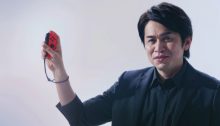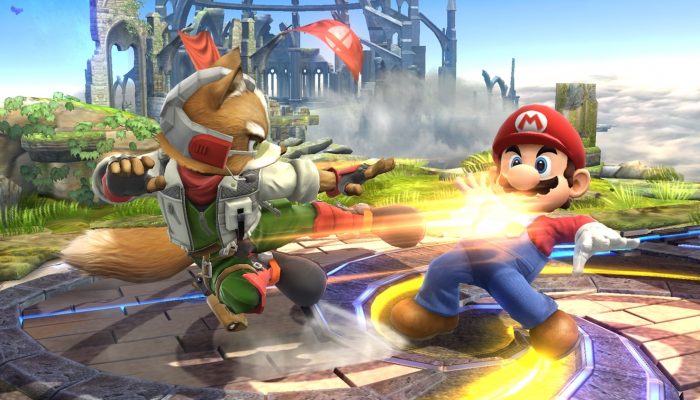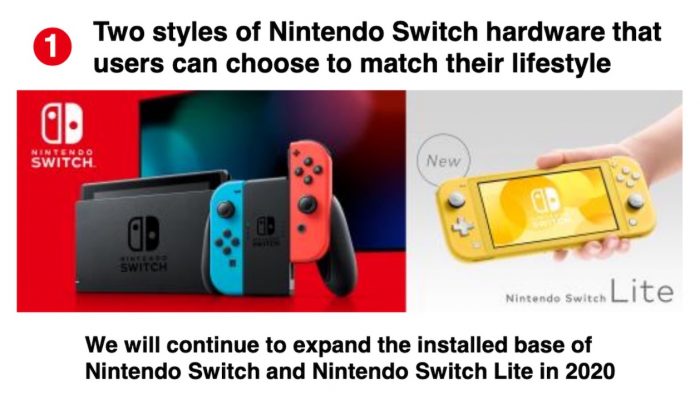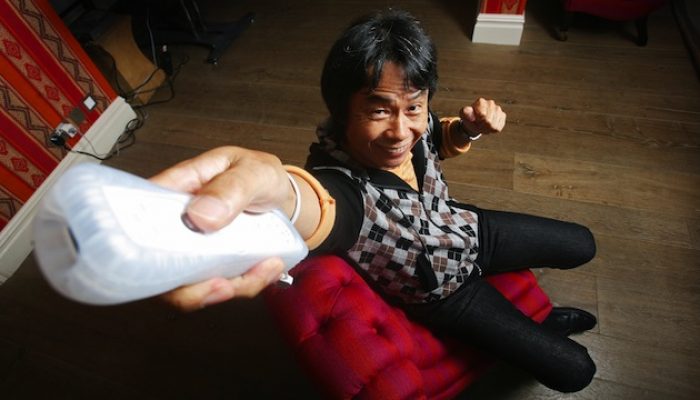 “Nintendo is a company which creates unique things and, once something unique is embraced by the public, there will be no competition in that market.”
“Nintendo is a company which creates unique things and, once something unique is embraced by the public, there will be no competition in that market.”
☆ NintendObs Event – Nintendo Q3 FY3/2017 Q&A.
★ NintendObs Daily – Monday, May 4, 2020.
Question 1:
I am sure that the hit smart-device application Pokémon GO greatly contributed to the phenomenal sales of (the Nintendo 3DS exclusive software) Pokémon Sun and Pokémon Moon. How will you link Nintendoʼs smart-device applications and software for dedicated video game systems to further expand the business going forward? Also, how frequently will Nintendo release smart-device applications in the next fiscal year and after?
Answer 1:
Tatsumi Kimishima (President):
We plan to continue releasing two to three titles per year that consumers can enjoy as Nintendoʼs smart-device applications.
Shinya Takahashi (Director, Managing Executive Officer):
We were sure that Pokémon GO would have some impact, but its extreme popularity and the incredible impact it actually had on the sales of Pokémon software for dedicated video game systems surpassed many peopleʼs expectations. It is possible to provide applications that feel related to the dedicated video game systems even if they do not have any direct connections. I believe that smart devices, particularly bigger ones like tablets, are easy for smaller children to use which makes it easier for them to experience Nintendoʼs IP (intellectual property), so we have been planning to create synergy between smart devices and our dedicated video game systems.
Shigeru Miyamoto (Director, Creative Fellow):
I attended two events regarding Pokémon GO, once when it was announced in September two years ago, and again during the announcement at E3 last year. However, it did not generate much buzz so I was just as surprised as everyone else by the reaction immediately following its release. I think that Pokémon GO ultimately had a huge impact on the sales for Pokémon Sun and Pokémon Moon, but Mr. Kimishima himself stated before that, though we could estimate the sales of the Pokémon GO Plus accessory (manufactured and distributed by Nintendo) before its release, we could not predict the extent of any other impact. We are aware that we should make use of the smart-device medium, which has spread further than dedicated video game systems, to appeal to younger generations in particular. We are continuing to work to maximize the impact of the connection with smart devices while actively spreading Nintendoʼs IP further, and (after experiencing the impact of Pokémon GO,) I am starting to see reactions that affirm this was not a mistake.
Pokémon is a game that is loved by people in a wide range of age groups, including those who played the original games when they were young, but this time we were able to grab the attention of many adults who had never played a Pokémon game before, even if they already knew about it. The degree to which it spread far exceeded our expectations. Also with Nintendo Entertainment System: NES Classic Edition that Nintendo released last year, we are realizing anew how important it is for Nintendo to catch the attention of both new consumers and consumers who stopped playing video games, and provide ways to overcome generational gaps so parents and children can play together (Nintendo Entertainment System: NES Classic Edition is sold in Europe and Australia as Nintendo Classic Mini: Nintendo Entertainment System).
We will continue to make use of smart devices in order to increase the amount of people who experience Nintendoʼs IP, and, though the Nintendo 3DS and, soon, Nintendo Switch will remain our most important business, we will continue to expand the smart-device business since it has gradually begun to contribute to Nintendoʼs business as a whole.
Question 2:
What was the top priority for Nintendo Switch development? Now that development has been completed, what is your impression?
Answer 2:
Takahashi:
Our top priority for hardware development was to create a home console video game system that you can play whenever and wherever you like, and it was critical for us to make it possible to carry it around with you even though it is a home TV game system. During development, when we first pulled the prototype system off the dock, although we of course had some idea of what to expect from the seamless play (from the TV screen to the screen on the main console unit), all of the attending developers were surprised at how fresh the actual experience was. Their excitement gave me great confidence in a strong outcome for this system. As for its software, taking 1-2-Switch for example, we have had a number of people outside the company try the demo. As a wide range of people thoroughly enjoyed playing it, including those in the higher age group, we were convinced that it would be enjoyed wherever people get together. Another impressive point for me was that, during the hands-on events, children and their parents were really enjoying playing it together.
Miyamoto:
As for me and Mr. Takeda, the developers of the younger generation at Nintendo would show us the hardware and software under development from time to time, and we gave them our advice. In doing so, I felt that our younger developers were correctly understanding the fact that Nintendo is a company which creates unique things and, once something unique is embraced by the public, there will be no competition in that market. The developers prioritized creating software titles with fairly unique content, perhaps emboldened in some respects because The Legend of Zelda: Breath of the Wild, an established franchise title, was also under development. As Mr. Takahashi just said, the consumers have already experienced some of these titles at our hands-on events, and I have felt very strong and positive reactions from them too. Throughout the development process of Nintendo Switch, I believe we were able to realize a number of unique features while maintaining a real Nintendo-esque feel.
Genyo Takeda (Director, Technology Fellow):
If I can sum up my impression in one short phrase, I would use “high performance but low power consumption” to describe Nintendo Switch. The PC has been a major gaming device, especially outside of Japan, and my top priority in the development of the Nintendo Switch hardware was to bring NVIDIAʼs GeForce, which has played a key role in realizing high-performance graphics for PC gaming, to our hardware with low power consumption. The term “crossover” is sometimes used to describe the unprecedented value that is realized when merging two different attractive things (such as, in this case, high performance and low power consumption, and playing both indoors and outdoors). I feel that Nintendo Switch is a new and unique crossover in its achievement of high performance, comparable to that of PC, both in front of your TV set and in your hands.
Question 3:
I believe that inadequate third-party support for the platform (and the lack of compatible software as a result) was the big issue for Wii U. Mr. Takeda just mentioned that Nintendo Switch is a high-performance system. From that viewpoint, I would like to know how third-party publishers are viewing Nintendo Switch. Also, how are Nintendoʼs internal developers appreciating Nintendo Switch and what kind of development direction are they taking in creating software for it? Also, what has technically been done for the system in order to realize the high performance of GeForce while managing the power consumption?
Answer 3:
Takahashi:
For our previous game platforms, creating our own development tools was a high priority for us. However, since the start of Nintendo Switch development we have been aiming to realize an environment in which a variety of different third-party developers are able to easily develop compatible software, such as by making it compatible with Unreal and Unity as well as our own development tools. As a result, even companies with only a few developers have already started making games for Nintendo Switch. The development of Snipperclips ‐ Cut it out, together! started with one such small team.
Since last year, we have introduced Nintendo Switch to a variety of different development companies by demonstrating software such as 1-2-Switch. At each demonstration, everyone was interested in the new play styles. During our recent (January 13) Nintendo Switch presentation, we played a video message from the creator of Skyrim, Mr. Todd Howard of Bethesda Game Studios, in which he shared the genuine impression he had already given us when we first showed him Nintendo Switch. Nintendo will keep on creating unique software. By doing so, I believe we will encourage third-party developers to create a number of quality software titles for Nintendo Switch.
Miyamoto:
Regarding our software development environment, we have taken the software development teams for home console systems and for handheld systems, which used to be two different departments, and integrated them into one, and this has been very beneficial as they are now developing software as a team in the same environment. In addition, third-party developers who are making software for PC can now easily adapt that software to work on our platform. In the current development environment, Iʼd say that it would take less than a year for them to port a PC game to Nintendo Switch. That ease of software development has also been felt by Nintendoʼs internal developers. Also, even though game software developers in the U.S. and E.U. are often said to have superior skills to their Japanese counterparts when it comes to software development techniques, Nintendoʼs software developers have mastered state-of-the-art technologies such as Unreal engine, and their skills can now be compared with those of Western developers. Our developers are more excited than ever to create software.
Takeda:
I have to refrain from disclosing any technological details, but we believe there are always technologies that are most appropriate to the time, and we have been very flexible when making technological selections. When NVIDIA was established in Silicon Valley in the mid-1990s, we were developing Nintendo 64 with Silicon Graphics, and we have respected each other as good rivals. This time, in order to develop Nintendo Switch with high performance in spite of its low power consumption, I feel it was key that the two companies could work together as partners while also fully displaying our individual craftsmanship.
Question 4:
How do you plan to make it so that Nintendo 3DS and Nintendo Switch will coexist in the marketplace? And, if the users start recognizing Nintendo Switch as a portable gaming device and using it as such, will it make sense for the company to release a next-generation portable game device?
Answer 4:
Kimishima:
As for your question on the Nintendo 3DS, we believe it can coexist with Nintendo Switch for the time being. Nintendo 3DS is a different system from Nintendo Switch in terms of its shape, weight, price and the types and number of available software titles. From this perspective, I believe parents will opt to choose Nintendo 3DS as their childrenʼs first video game system. So we recognize that Nintendo 3DS as a portable game device meets different needs and fits different markets than Nintendo Switch, and we will keep this recognition in mind as we consider the future of our dedicated portable video game business.
Takahashi:
We have been developing new software titles for Nintendo 3DS, so please look forward to them. As for your question about a next-generation portable game system, because Nintendo never stops thinking about and researching potential future video game systems, it is not a question of whether it may make sense to release some specific product in the future. We are always engaged in researching and considering our next video game system.
Question 5:
Is Nintendo considering working with companies other than DeNA to develop games for smart devices in the future? Also, are you considering using the Mario brand to raise profits for the smart-device business in the next financial year?
Answer 5:
Kimishima:
I do not think that we would have been able to provide smart-device applications to our consumers without DeNAʼs support, so in that sense our partnership with them is going extremely well. I will not deny that in the future, depending on the status of our smart-device business and what consumers are asking for, we may ask for additional support from other companies, but we are not currently pursuing partnerships opportunities with any other specific companies.
Takahashi:
We are using Mario in many aspects of Nintendoʼs business, so I am sure we will make use of him. However, I do not mean that we will absolutely release a new Mario game for smart devices in the next fiscal year, but rather that Mario currently plays and will continue to play a very active role in many areas of our business.
Miyamoto:
We are trying out many different types of applications for smart devices, including different titles and payment models. The payment model for Super Mario Run was one thing we tried, so I want to continue to follow the results. We changed the distribution schedule we had originally released and distributed Super Mario Run ahead of other applications. We were not hiding it, but as we were developing it alongside other applications, we felt that we had really come up with something great so we decided to (change the schedule to) work toward release.
We always work flexibly like this, so since we are able to develop smart-device applications in a relatively short amount of time, we may get an interesting idea about how to use Mario and end up making a Mario application and releasing it with a quick turnaround. In that sense, we will decide whether or not to release a new Mario title in the next fiscal year as we continue to monitor the status of the market.
Question 6:
You have announced that Nintendo Switch will be introducing a subscription-based service. Do you believe this will contribute to stable and ongoing revenue and profit for Nintendo? Please also describe the direction you plan to take in the future in regards to competitive online play.
Answer 6:
Kimishima:
The profitability of our business ventures depends on how our products are received by our consumers. Therefore, in order to raise revenue in a stable manner, we have to release new products continuously. However, the entertainment business is subject to consumersʼ ever-changing tastes. We believe that the only way to meet this challenge is to fully employ our creativity to satisfy our consumers. Furthermore, in the past it was common for the launch dates of our products to vary between Japan, the U.S. and Europe, but with the instant spread of information in the world today, launches are by necessity much closer to one another. This means that, in some cases, peak sales are concentrated in a certain period of the product lifecycle. In this situation, we have been working to establish more balanced revenue and expense structures to the extent possible by continuously seeking out opportunities to expand our business in multiple directions through the use of our IP.
Takahashi:
As for competitive online play, there has been a very active scene for Splatoon on Wii U, and we have announced titles such as Splatoon 2, Mario Kart 8 Deluxe and ARMS to continue to provide exciting online experiences. Of course, we will also offer non-competitive online play experiences. However, Nintendo has also consistently placed value on experiences that can be enjoyed without going online. To balance these two approaches, we will continue to release titles in all three categories: games that can be enjoyed without going online, games that are best enjoyed online, and games that are fun whether online or offline.
Question 7:
I would like to hear more about the current and future direction of your development structure, which is widely considered to be your greatest competitive strength. Do you plan to maintain the current scale for the mid- to long-term, or will you expand it? How will you expand the smart-device team within the larger development structure? My assumption is that there are currently fewer than 100 people on this team, do you think that is sufficient? Also, what sort of employees are needed to help Nintendo grow and evolve in the future, and how do you plan to develop these employees?
Answer 7:
Kimishima:
Our overall development staff has increased over the past year, but that does not mean it will necessarily continue to increase. In the entertainment industry, it is very common to take the approach of hiring employees who already have experience and technical knowledge in needed areas, in addition to developing new technology and ideas within the company. Going forward, we would like to increase the number of employees who already have some technical ability and who have fun ideas that can inspire new game experiences. These are the kind of people we see as necessary in our field of development. For smart devices, we have been developing using one of our most important IPs, Mario, so instead of using a team that had no prior experience with Mario, we had developers who worked on past Mario games join the development of Super Mario Run. The scale of the team we currently have working on apps is not as large as you surmise.
In the future, while we will plan the course of development, we may not necessarily allocate exclusively internal development resources. We would like to continue cooperating with external partners who understand Nintendo well when the situation calls for it.
Miyamoto:
Software and service sales are becoming increasingly crucial to overall sales, and this encourages greater expenditures on personnel. However, if we were to attempt to take everything on ourselves, we would have to increase our staff dramatically, and that would mean that we could not nurture those resources sufficiently. This is one of our greatest challenges. That is why we are working on development with a number of external partners. Employees in their 30s are the main part of the next generation, and as more of these employees become able to take on management roles, we will be able to strengthen our development talent. However, we constantly face the dilemma that simply hiring new people may increase the number of people who donʼt have a deep understanding of Nintendoʼs DNA. I have shared with Mr. Takahashi that although it takes four times as many people to create the products now, if we simply hire four times as many people we wonʼt have sufficient opportunities to nurture them. We are considering a number of approaches to this challenge, so please look forward to more information in the future.
Takeda:
Nintendo is not directly involved in developing the basic technology, but technical innovation is important in the entertainment industry. Until recently, it was sufficient to have expertise in computer science fields such as semiconductors, but we have needed to expand our knowledge in a greater variety of fields over the last few years. Therefore, our appraisal ability has become ever-more important, and we believe that we need to focus on our ability to adopt a certain technology and transform it to suit our purposes. While we continue to focus on this ability, we feel it is also important to pursue outsourcing opportunities with universities and external partners, so we donʼt think that a sudden increase in staffing is the only solution.
Question 8:
Mr. Kimishima, what do you feel is your goal as a manager in considering your successor? What sort of person do you think would be appropriate to lead the company in the future?
Answer 8:
Kimishima:
I believe that my personal role is to consider how to create an internal structure that will allow Nintendo to continue to release entertaining products in the future.
When I took on the President position, it was still too early to reveal the full details of Nintendo Switch, our smart-device business and our efforts to use Nintendoʼs IP. I have been working with both Fellows since then to make sure that these business ventures could get off to a successful start.
We have to bring in the next generation to ensure the continuity of the company into the future, so it is important to create an organizational structure where young people can take on more responsibility and flourish. This is true not only in considering my own successor, but in regards to all of the organizations and structures within the company, and one of my main roles is to create that type of system.
I believe Nintendo constantly needs to undertake new endeavors. The integrated hardware and software business is at the heart of Nintendoʼs business and I believe it is important that we continue our strong commitment to that business, but it is also my mission to expand the smart-device and Nintendo IP businesses, and to find and nurture the seeds of new entertainment experiences as new technologies emerge.
Nintendo has plenty of talented employees and leaders in each department who oversee these employees. I think it is my responsibility to find a person who will be able to oversee those leaders and who will be skilled at running the overall organization.
— Nine Months Financial Results Briefing for Fiscal Year Ending March 2017
Source: Nintendo JP.
At NintendObserver, the comments are on Discord.
Click on Community to learn more. 🙂
…
…Wanna play? Buy a Wii U.
And if you’ve already got yours, here are all the games already available on the platform. 😀



